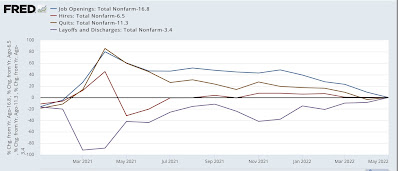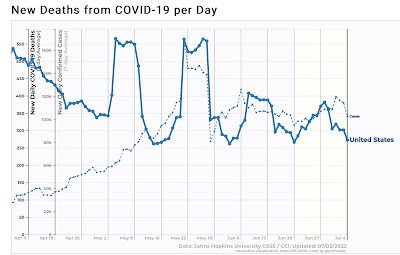- by New Deal democrat
I have written before that the typical divide between “economic” and “social” issues isn’t quite correct. Most “social” issues, it turns out, are really “moral” issues, where some people are opposed because they believe the activity to be allowed is immoral.
While it is usually not too difficult to find a compromise on economic issues, asking someone to compromise on a matter of morality is usually a lost cause.
That being said, even for moral issues, a doctrine of “live and let live” usually works, so long as neither side requires the other side to personally act in accordance with the opposing view. For example, nobody else is actually harmed by allowing two consenting adults to get married, regardless of their gender. At the same time, I wouldn’t require a baker who is opposed to gay marriage to bake a cake for the couple in his proprietary business (and would you *really* want to eat such a cake, not knowing what extra “ingredients” may have been added?).
But that doesn’t work with abortion, because one side believes the act of the other side is inherently murder. There is no zone of “let live,” because one side unalterably believes that there is a third party involved.
Nevertheless,
Daniel Conkle, a Professor Emeritus of Constitutional Law at the Indiana University Law School, penned an editorial for Politico in which he wrote that, after Dobbs’ reversal of Roe v. Wade (note: I’ve changed the order of several paragraphs for clarity):
“our current reality [ ] will lead to conflict and litigation between states…. Partisan polarization will be exacerbated, and the risk of abortion-related violence will grow. Our precarious social fabric will be torn apart, further imperiling our already weakened sense of commonality and nationhood.
“[Further, w]ithout something close to a consensus, abortion laws [will] always be ripe for reversal if the next election.
“To avoid these consequences, lawmakers will have to meet in the middle.
“To be potentially viable, a national compromise would include four elements. First, it would permit abortion during a specified period of gestation, without restriction, during the few first months of pregnancy. Second, it would prohibit abortion later in pregnancy. Third, even after this point in pregnancy, there would be exceptions to the abortion prohibition. And fourth, the congressional compromise would be national in scope, with federal law controlling the issue of abortion and preempting state law to the contrary. The fourth element, federal preemption, bears emphasis.
“It means that the congressional compromise would displace and nullify state abortion policies. There would be the same right to abortion in red and blue states alike, subject to the same limitations”
Actually, no. The majority in Roe very succinctly themselves added a summary of their holding, to wit:
“To summarize and to repeat:
“….
“(a) For the stage prior to approximately the end of the first trimester, the abortion decision and its effectuation must be left to the medical judgment of the pregnant woman's attending physician.
“(b) For the stage subsequent to approximately the end of the first trimester, the State, in promoting its interest in the health of the mother, may, if it chooses, regulate the abortion procedure in ways that are reasonably related to maternal health.
“(c) For the stage subsequent to viability, the State in promoting its interest in the potentiality of human life may, if it chooses, regulate, and even proscribe, abortion except where it is necessary, in appropriate medical judgment, for the preservation of the life or health of the mother.”
In the companion case of Doe v. Bolton, the Court defined health as "all factors – physical, emotional, psychological, familial, and the woman's age – relevant to the well-being of the patient."
There are three major differences between Roe and Professor Conkle’s proposed compromise:
1. Conkle says abortion should be permitted “during the first few months of pregnancy. Roe drew the line at viability, which in the 1970s was at 6 months, but due to progress in medicine, has moved earlier by 2 to 4 weeks during the 5th month.
2. Conkle says abortion would be prohibited “later in pregnancy.” Contra Lemieux’s assertion, paragraph “(c)” of the Roe opinion explicitly stated that the State *may* - but does not have to - regulate or forbid abortions. In other words, Roe permitted abortions right up until the moment of birth, if a State were to so decide.
3. Further, the definition of “health” as set forth in the companion Doe case went far beyond physical health with regard to permitting abortions after viability, including “emotional, psychological [and] familial” issues, including ones that may be transient in nature.
To go back to my initial paradigm, is there any sort of “grand bargain” to be had? I think not, in the sense of a compromise where all parties feel the outcome is satisfactory enough to live with. Those who believe that human life begins at conception and is at all points thereafter sacred, consider abortion murder. They are not going to compromise by allowing “some” murder. On the other hand, there are those who believe that abortion should be available on demand at all times. They are not going to be interested in the above proposed compromise either.
But if there is no “compromise” to be had in the generally accepted meaning of the word, there probably is a middle zone where the minimum number of people feel unalterably and implacably opposed, which in the long run is probably what society ought to aim for. With one exception Professor Conkle’s proposal comes pretty close.
For over 40 years, polls have shown that most Americans are comfortable with first trimester abortions, and become increasingly opposed as it gets later in the second trimester. A law which permitted abortion through the first trimester, and perhaps up until quickening (the historical dividing point which occurs when fetal movement can be felt, usually during the fourth or early fifth month) would likely meet with wide approval.
Further, a law which forbade abortion except for serious *physical* health complications to the mother thereafter, or to prevent the birth of a severely deformed newborn which was doomed to a brief and painful life, would probably also find wide acceptance.
So far, this is basically Conkle’s proposal.
Where I part company with Conkle is as to his final prong, namely that there would have to be a uniform nationwide law. In fact, I think exactly the opposite is true. Once the parameters are set, there ought to be room for local variation. For example, first trimester abortions are permitted, while abortions after viability are banned with the physical health exception I specified above. In between those boundaries, reasonable regulations, restrictions, and prohibitions could vary between jurisdictions.
In fact, I would go further than just making a matter of State differences. I think the best chance of finding an accommodation would allow localities to differ; e.g., rural Mississippi might be an abortion desert, while Jackson, Mississippi might adopt a more liberal rule. Basically, the majority’s ox doesn’t get gored in their local area; but they can’t gore the ox of the majority in the locality next door; and those who need to travel to accommodate their need don’t have to travel too far.
We already have an example of allowing this variability in US history, with the issue of prohibition. After over 50 years of profound agitation, the 18th Amendment to the US Constitution was adopted, enshrining nationwide the sale or consumption of alcohol. Thus, by the way, taking away from average Americans a right they had always had - something that Dobbs just did, the first time the Supreme Court has done so in over 200 years.
After only 14 years, the 18th Amendment was repealed by the 21st. But the repeal specifically allowed States to set their own policies, including prohibition, if they so chose. Three States - Kansas, Oklahoma, and Mississippi - kept statewide prohibition for years afterward, with Mississippi - the last holdout - only repealing prohibition in 1966. The other States allowed a welter of regulations, including “dry” counties, some of which still exist.
The abortion issue may yet be a fundamental issue tearing this country apart. But if it is ever to be relatively minimized as an issue, a proposal like Conkle’s but allowing state and local variation within certain boundaries is how that is going to be achieved.














